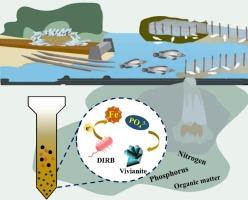Green and efficient recovery of phosphorus as Vivianite via anaerobic fluidized bed reactor (AFBR) from aquaculture wastewater
IF 6.7
2区 工程技术
Q1 ENGINEERING, CHEMICAL
引用次数: 0
Abstract
The expansion of aquaculture has led to high-density farming wastewater rich in Total Phosphorus (TP) and Chemical Oxygen Demand (COD), causing severe eutrophication. In response to the low phosphorus recovery efficiency observed in conventional fish aquaculture wastewater (AWW) systems, a novel phosphorus recovery process was developed by integrating an anaerobic fluidized bed reactor (AFBR) with the formation of vivianite (Fe₃(PO₄)₂·8H₂O) as the precipitate product. The long-term laboratory-scale trials demonstrated the performance of the AFBR in treating AWW. Optimization of the iron source to FeCl₃ enabled the AFBR to achieve a vivianite recovery efficiency of 77 %, along with the phosphorus removal of 98 % and the COD removal efficiency of 99 %. Parameter optimization experiments revealed that extending the hydraulic retention time (HRT) to 24 h and increasing the upward flow velocity to 12 m·h−1 improved phosphorus recovery efficiency by 11 % and 5.8 %, respectively. Based on the Life Cycle Assessment (LCA) and cost analysis, the FeCl₃-enhanced AFBR process producing vivianite offers better environmental performance and a net profit of 0.54 USD per ton of AWW treated.This study presents an efficient, eco-friendly, and cost-effective method for phosphorus recovery from the AWW, offering new insights into the high-value conversion of aquaculture effluents.

厌氧流化床反应器(AFBR)绿色高效地回收水产养殖废水中的磷
水产养殖规模的扩大导致高浓度的养殖废水中富含总磷(TP)和化学需氧量(COD),造成严重的富营养化。针对传统水产养殖废水(AWW)中磷回收率较低的问题,采用厌氧流化床反应器(AFBR)形成橄榄石(Fe₃(PO₄)₂·8H₂O)作为沉淀产物,开发了一种新型磷回收工艺。长期的实验室规模试验证明了AFBR在治疗AWW方面的性能。优化铁源为FeCl₃,使AFBR的活石回收率为77%,除磷率为98%,COD去除率为99%。参数优化实验表明,将水力停留时间(HRT)延长至24 h,将向上流速提高至12 m·h−1,可使磷回收率分别提高11%和5.8%。基于生命周期评估(LCA)和成本分析,FeCl₃增强AFBR工艺生产活钙石具有更好的环保性能,每处理一吨AWW的净利润为0.54美元。本研究提出了一种高效、环保、经济的AWW磷回收方法,为水产养殖废水的高价值转化提供了新的见解。
本文章由计算机程序翻译,如有差异,请以英文原文为准。
求助全文
约1分钟内获得全文
求助全文
来源期刊

Journal of water process engineering
Biochemistry, Genetics and Molecular Biology-Biotechnology
CiteScore
10.70
自引率
8.60%
发文量
846
审稿时长
24 days
期刊介绍:
The Journal of Water Process Engineering aims to publish refereed, high-quality research papers with significant novelty and impact in all areas of the engineering of water and wastewater processing . Papers on advanced and novel treatment processes and technologies are particularly welcome. The Journal considers papers in areas such as nanotechnology and biotechnology applications in water, novel oxidation and separation processes, membrane processes (except those for desalination) , catalytic processes for the removal of water contaminants, sustainable processes, water reuse and recycling, water use and wastewater minimization, integrated/hybrid technology, process modeling of water treatment and novel treatment processes. Submissions on the subject of adsorbents, including standard measurements of adsorption kinetics and equilibrium will only be considered if there is a genuine case for novelty and contribution, for example highly novel, sustainable adsorbents and their use: papers on activated carbon-type materials derived from natural matter, or surfactant-modified clays and related minerals, would not fulfil this criterion. The Journal particularly welcomes contributions involving environmentally, economically and socially sustainable technology for water treatment, including those which are energy-efficient, with minimal or no chemical consumption, and capable of water recycling and reuse that minimizes the direct disposal of wastewater to the aquatic environment. Papers that describe novel ideas for solving issues related to water quality and availability are also welcome, as are those that show the transfer of techniques from other disciplines. The Journal will consider papers dealing with processes for various water matrices including drinking water (except desalination), domestic, urban and industrial wastewaters, in addition to their residues. It is expected that the journal will be of particular relevance to chemical and process engineers working in the field. The Journal welcomes Full Text papers, Short Communications, State-of-the-Art Reviews and Letters to Editors and Case Studies
 求助内容:
求助内容: 应助结果提醒方式:
应助结果提醒方式:


